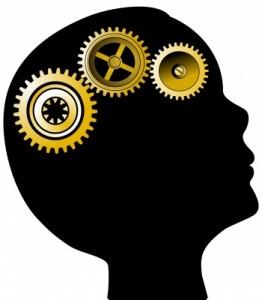Behavior
 All of the brain’s building blocks are used to generate behavior. Behavior is any observable activity of an animal, including humans. A person’s behavior can be a response to a stimulus from our environment, but it can also be self-initiated. Behaviors range from simple behaviors, such as a reflex like swallowing, to complex behaviors, such as talking.
All of the brain’s building blocks are used to generate behavior. Behavior is any observable activity of an animal, including humans. A person’s behavior can be a response to a stimulus from our environment, but it can also be self-initiated. Behaviors range from simple behaviors, such as a reflex like swallowing, to complex behaviors, such as talking.
Behaviors can be categorized as instinctive or learned. Instinctive behaviors are made up of rigid, stereotyped movements that are similar in all individuals in a species. Learned behaviors include any goal-directed behaviors, like learning to play a sport or drive.
All animals have both instinctive and learned behaviors. Animals that live only a short time, such as insects, rely more on instinctive behaviors, while animals that live longer, like us, rely more on learned behaviors. We learn behaviors from watching others, from instruction, and from trial-and-error.
On any given day, our behaviors are influenced by our genes and our environment, both physical and social (in other words, other people). How we respond to a stimulus can be affected, or modulated by our own hormones, mood, attention level, health, and personality.
Our early life experiences can affect how we behaviorally respond to particular events later in life. These experiences can epigenetically[1] modulate gene expression to stimuli years later. What are eipigenetic mechanisms? They are mechanisms that influence how genes act without changing the gene itself.
How do scientists study behavior? As Manning notes, “Behavior is continuous for as long as the animal lives and, strictly speaking, every movement counts[2].” Thus scientists have to categorize, simplifying the animal’s actions into discrete units. For people, psychologists can use the person’s own self-reporting; they can observe the person in an experiment; or they can measure a behavioral component such as heart rate or breathing in response to a stimulus.
References
[1] Roth TL, Sweatt JD (2011) Annual Research Review: Epigenetic mechanisms and environmental shaping of the brain during sensitive periods of development. J of Child Psychol and Psych 52(4): 398-408.
[2] Manning, A. (1979) An introduction to animal behavior. Edward Arnold Publishers, Ltd.London. 329 pp

